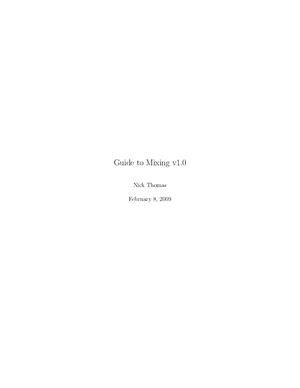2009
This document is a guide to the essential ideas of audio mixing, targeted
specifically at computer-based producers. I am writing it because I haven't
been able to fnd anything similar freely available on the Inteet. The Inteet
has an incredible wealth of information on this subject, but it is scattered across
a disorganized body of articles and tutorials of varying quality and reliability.
My aim is to consolidate all of the most important information in one place, all
of it verifed and fact-checked.
This guide will not tell you about micing techniques or how to track vocals
or what frequency to boost to make your guitars really kick. There's plenty of
stu® written already on mixing live-band music. This guide is specifcally for
computer-based electronic musicians, and so it is tailored to their needs.
On the other hand, this guide does not assume that you are making club-
oriented dance music. Certainly the advice in here is applicable to mixing electro
house or hip-hop, but it is equally applicable to mixing ambient or IDM.1 On the
other hand, dance music does pose special mixing challenges, such as the tuning
of percussion tracks and the achievement of loudness, and these challenges are
given adequate time, since they are relevant to many readers.
In this document, I assume only very basic prior knowledge of the concepts of
mixing. You should know your way around your DAW. You should know what
a mixer is, and what an e®ect is, and how to use them. You should probably
have at least heard of equalization, compression, and reverb. You should have
done some mixdowns for yourself, so that you have the °avor of how the whole
process works. But that's really all you need to know at this point.
I do not claim to be an expert on any of this material. I have, however,
had this guide peer-reviewed by a number of people, many of them more knowl-
edgable about mixing than I. Therefore, I think it's fair to say that at the very
least it does not contain many gross inaccuracies. I thank them for their e®ort.
If you have questions, comments, or complaints of any kind about anything
I've written here, please write nhomas(собачка)gmail.com.
Contents
1 Sounds
1.1 Frequency Domain
1.2 Pattes of Frequency Distribution
1.3 Time Domain
1.4 Loudness Perception
1.5 Digital Audio
2 Preparation
2.1 Monitors
2.2 Volume Setting
2.3 Plugins
2.4 Ears
2.5 Sound Selection
3 Mixer Usage
4 Equalization
5 Compression
6 Space Manipulation
7 Conclusion
7.1 Putting It All Together
This document is a guide to the essential ideas of audio mixing, targeted
specifically at computer-based producers. I am writing it because I haven't
been able to fnd anything similar freely available on the Inteet. The Inteet
has an incredible wealth of information on this subject, but it is scattered across
a disorganized body of articles and tutorials of varying quality and reliability.
My aim is to consolidate all of the most important information in one place, all
of it verifed and fact-checked.
This guide will not tell you about micing techniques or how to track vocals
or what frequency to boost to make your guitars really kick. There's plenty of
stu® written already on mixing live-band music. This guide is specifcally for
computer-based electronic musicians, and so it is tailored to their needs.
On the other hand, this guide does not assume that you are making club-
oriented dance music. Certainly the advice in here is applicable to mixing electro
house or hip-hop, but it is equally applicable to mixing ambient or IDM.1 On the
other hand, dance music does pose special mixing challenges, such as the tuning
of percussion tracks and the achievement of loudness, and these challenges are
given adequate time, since they are relevant to many readers.
In this document, I assume only very basic prior knowledge of the concepts of
mixing. You should know your way around your DAW. You should know what
a mixer is, and what an e®ect is, and how to use them. You should probably
have at least heard of equalization, compression, and reverb. You should have
done some mixdowns for yourself, so that you have the °avor of how the whole
process works. But that's really all you need to know at this point.
I do not claim to be an expert on any of this material. I have, however,
had this guide peer-reviewed by a number of people, many of them more knowl-
edgable about mixing than I. Therefore, I think it's fair to say that at the very
least it does not contain many gross inaccuracies. I thank them for their e®ort.
If you have questions, comments, or complaints of any kind about anything
I've written here, please write nhomas(собачка)gmail.com.
Contents
1 Sounds
1.1 Frequency Domain
1.2 Pattes of Frequency Distribution
1.3 Time Domain
1.4 Loudness Perception
1.5 Digital Audio
2 Preparation
2.1 Monitors
2.2 Volume Setting
2.3 Plugins
2.4 Ears
2.5 Sound Selection
3 Mixer Usage
4 Equalization
5 Compression
6 Space Manipulation
7 Conclusion
7.1 Putting It All Together

